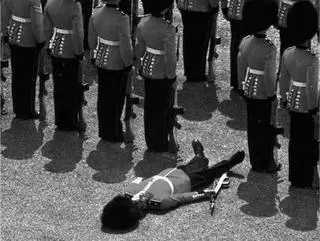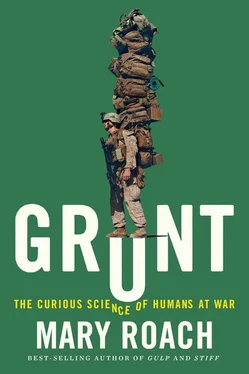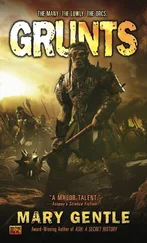Unfortunately for pigs, the layout and size of their viscera approximate ours, as do their blood pressure and the rate at which they bleed. Goats are better for practicing emergency airway procedures, as there’s not four inches of neck fat to slice through.
I watched a YouTube clip purporting to be part of a live tissue training class that someone surreptitiously filmed. A group of men stand around a folding table on a rainy day. A makeshift roof with a tarp drips overhead. Two or three men at a time lean over an inert pig laid out on the table. Their backs are to the camera. They chat quietly. They look like pit masters at a whole-hog barbecue. A veterinarian is there, and you can hear someone ask him to give the animal a bump, meaning more anesthesia. The leg amputation happens off-camera, but you can see the instrument the instructor uses: a set of long-handled shears of the sort one might use to cut through chain link. It sounds ghastly but gets the job done quickly. Assuming the anesthetic was competently administered, the proceedings struck me as no more upsetting than what goes on in slaughterhouses every day in the name of bacon and chops and short rib ragu.
For that very reason, Siddle feels, it’s an incomplete “stress inoculation.” “While it’s a good experience to work on something live, something that pumps, it’s not a human. It’s not screaming.” To gain experience with actual screaming humans, Camp Pendleton’s corpsman trainees may spend time observing and helping out in an emergency room in a gang-saturated Los Angeles neighborhood. “That’s our equivalent of Iraq or Afghanistan,” Ali said earlier. “Gunshots, strafings, stabbings.”
Michelle, the other Cut Suit Operator-in training, experienced both live tissue training and a stint in an emergency room. She found them helpful in different ways. Live tissue training provides a controlled teaching environment. Students can try things out, grab a slippery artery between two fingers to stanch a bleed. “You’re not,” she said, “going to be doing that with a patient in an emergency room.”
With its bleeding, wheezing, cursing role-players, Strategic Operations tries to be one-stop shopping: something pumping, human, and screaming. “It creates a willful suspension of disbelief,” says Stu, disarticulating a fried fish. I don’t quite understand that phrase, but I do understand what he says next. “We’ve had students wet themselves, soil themselves, vomit, faint.”
Lavell shares that Dennis Kucinich lost his congressional lunch at a Cut Suit demo. The representative from Ohio was sitting in the front row with his wife, Elizabeth, the prominent DC vegan and animal rights advocate. “When the actor started screaming and the blood started spurting, Kucinich went white. You could see the reverse peristalsis beginning.” I glance at neighboring tables, half expecting to see some here. “His wife got up and helped him to the door.”
THE MAIN stressor of combat medicine is absent from every training simulation. No one is shooting real bullets at or anywhere near you. “Training is limited by liability,” said Siddle. He sounded a little mournful.
“The high number of returnees diagnosed with PTSD suggests we are not doing enough,” scolds Colonel Ricardo Love in his paper. Love hailed the ancient Spartans’ approach to “building psychological resilience in their forces.” Pelopidamus, looketh upon these novel strategies for building resilience. “On several occasions [the] war games were deadly and some boys were killed.” According to Sparta scholar Paul Cartledge, other military resilience-builders included the stalking and killing of random slaves and “the braving of whip-lashing seniors [25] I suppose that by “seniors” Cartledge means people older than the boys; however, Spartan senior citizens weren’t the courtly walker-pushers of current stereotype. “Tribal elders” would screen babies for military worth; those deemed unfit were hurled into a chasm called “the deposits.” Nothing in antiquity makes much sense. Who gives cheese to a goddess of vegetation?
in order to steal the largest possible number of cheeses from the altar of (Artemis) Ortheia, a goddess of vegetation and fertility.”
Many years ago, reporting a story on killer bees, I experienced a kind of stress inoculation. I accompanied a team called out to remove a hive on a farmer’s land in south Texas. The venom of “killer” honeybees is the same as that of ordinary honeybees, but the bees are far more aggressive in their defense of the hive and their pursuit of interlopers. The larger the hive, the more defensive the bees. This hive filled a fifty-five-gallon oil drum. I wore a bee suit, but I hadn’t attached the veil properly and bees began getting underneath it and stinging me. Later that day I and my throbbing welts visited a keeper of ordinary honeybees. While we talked, bees would light on my arm. My normal reaction would have entailed flailing and girly alarm noises. Instead I calmly watched them crawl around. Fear of bees: gone.
But would it have worked in reverse? Would exposure to regular honeybees have inoculated me against the fear I felt inside the killer bee swarm? Caezar’s theatrics and Tom Hanks yelling and the hectoring instructors—these are regular honeybees. Still, as Siddle allows, “Anything that narrows the gap is good.”
The other way to train medics is to have them practice a skill so many times that it becomes automatic. So when the prefrontal cortex goes AWOL, when reasoning drops away, muscle memory, one hopes, will persist. Do it enough times, and you can administer first aid in the ultimate survival stress scenario: when the gore is your own. Recall the combat engineer from chapter 4 who’d stepped on an IED. “Without thinking”—as he aptly put it—he pulled out a tourniquet and placed it perfectly on what remained of one leg.
CAN THE carnage of an explosion ever really not be stressful? Does a disarticulated head ever come to seem normal? Apparently. “After a while,” Ali told me during a break from the tutorial, “it’s just a head. You get on with your job.” Michelle told a story from her deployment in Iraq. She was carrying part of a Marine’s leg that had been blown off by an IED. The foot was still in the man’s boot, and presently his buddy went to pull it out. When the boot relinquished its hold, the foot smacked Michelle in the face. She made a face that led me to assume the foot had started to decompose. “It wasn’t decomposed,” she said. “It was a brand-new, blown-off foot.” She leaned closer. “He wasn’t wearing socks.” What repelled Michelle was not blood or gore, not the foot’s detachment from the rest of the body or the awful deadness of it, but the smell and feel of the sweat on her cheek.
And that will serve as my lurching segue to the miraculous, reviled excretions of the human eccrine gland. In a place like Afghanistan, sweat keeps more people alive than corpsmen do.
7. SWEATING BULLETS
The War on Heat

FORT BENNING, GEORGIA, HAS three key ingredients for heatstroke: humidity, intense sun, and Army Ranger School. Rangers, like their better-known cousins Navy SEALs, are part of the US Special Operations forces. To borrow the words of their creed, the Ranger is an “elite soldier” expected to “move further, faster and fight harder than any other soldier.” Josh Purvis would seem to be maximally elite in that he was, when I met him, an instructor at Army Ranger School and a contender for the annual Best Ranger Competition. The competition falls into the category of a multisport event, surely the only one to include a Bayonet Assault Course and a litter carry. (They don’t mean trash.) Competitors march and run twenty-plus miles with a sixty-pound pack, and every year, a few will experience a second litter carry, in the horizontal position. In 100-degree heat, “further, faster” can be a lethal undertaking.
Читать дальше













